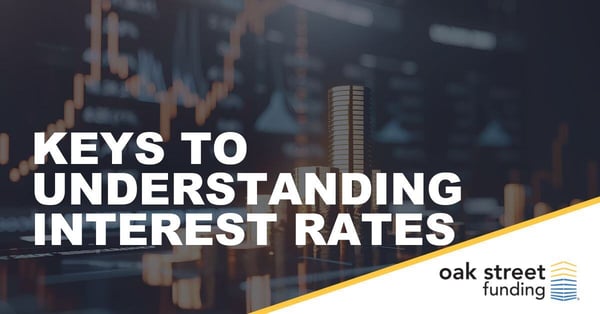
Congratulations. Your business is growing and now it’s time to look for a loan to continue the cycle. Maybe you’ve met a lender or two at a networking event and are considering giving them a call. Before starting to dial, be sure to understand the basics of how your loan will be funded.
The average borrower may not realize there are differences in how lenders determine loan interest rates, so here is a primer on the subject.
What is interest?
Banking institutions hold money from depositors and lend that money to borrowers; the interest borrowers pay allows the lender to make a profit. The interest rate charged must be more than what the lender could earn on those funds elsewhere, or it wouldn’t make sense to make loans rather than invest in higher-return opportunities.
There are strong market forces at work to determine what interest rate lenders charge each customer. These market forces keep interest rates competitive because borrowers know they can choose among lenders – based on customer service, industry expertise, down payment required, fees, and interest rate offered.
How is interest on a loan determined?
To set the interest rate for a given loan, lenders start with a benchmark, then adjust it based on the credit worthiness of the borrower, the size of loan, market conditions, and the purpose of the loan, the length of the loan and its inherent risk. Different lenders start with different benchmarks. To understand the process, it’s helpful to be familiar with three rates: the federal funds rate, the prime rate, and the Treasury Yield.
1. Federal funds rate
Financial institutions must maintain a certain level of their depositors’ funds at the Federal Reserve. Those banking institutions that have more cash on hand than they need to meet their reserve requirement may choose to leave it with the Federal Reserve, earning at the interest on reserve balances (IORB) rate, or lend it to financial institutions that need extra cash to meet their reserve requirement. When they choose the latter option, market competition sets a higher rate for interest on those institution-to-institution overnight loans. A rolling average of that rate is known as the federal funds rate (FFR).
At its eight meetings throughout the year, the Federal Open Market Committee (FOMC) of the Federal Reserve (the Fed) sets a target rate for the FFR. It is an important tool in managing monetary policy. While the Fed cannot dictate the FFR, it can make other changes that influence it to keep it in the target range. For example, if the FFR is getting too high, the Fed can take steps to reduce liquidity in the market (quantitative tightening).
2. Prime rate
The federal funds rate is important because it is the basis on which the prime rate is determined. The Fed does not set prime rate; it is determined by banking institutions themselves. As a rule of thumb, the prime rate is usually the FFR plus three.
For other borrowers, banks calculate an interest rate based on the prime rate benchmark, plus additional percentages based on the borrower’s credit history, the amount being borrowed, and the specifics of the loan. Most home mortgage and car loan interest rates are based on the prime rate, as are some small business loans. The prime rate is also commonly used as the basis for variable-rate loans.
3. Treasury yield
Oak Street Funding uses various treasury yields as the benchmark for setting interest rates. Treasury yield is the annual interest rate that the U.S. government pays on its debt. It is also the return investors can expect from holding U.S. government securities. We use the 1-month treasury yield for variable rate loans and various longer-term treasury yields for fixed rate loan options. Not all lenders use this method. At a 101 level, this means our team offers rates based on a spread above a U.S. Treasury rate. If a borrower has a variable rate loan, the all-in rate would be priced based on a spread above the one-month US treasury yield.
Why this is important
A variable rate tied to the prime rate may seem appealing today based on current expectations that the Fed will cut rates. However, treasury rates are anticipatory and are already declining ahead of the Federal Rate cuts. Treasury rates are a better indication of market expectations and are a more accurate representation of the investor confidence.
Long-term interest rates have already declined based on the expectation of near-term rate cuts. For example, the 10-year Treasury rate declined from 4.69% on April 30, 2024, to 3.86% on August 22, 2024. Ask and understand this important nuance behind how lenders derive your loan rate. It’s in your best interest.
There are many ways to put together a deal that will work for all parties involved. Look for lenders that have the flexibility to create solutions – from business acquisition loans to succession loans to partner buy-in loans that match the needs of buyers and sellers alike.



/Resources%20Thumbnails%20(47).png)

/Resources%20Thumbnails%20(20).png)